
Sir Thomas Bouch was a British railway engineer. He was born in Thursby, near Carlisle, Cumberland, and lived in Edinburgh. As manager of the Edinburgh and Northern Railway he introduced the first roll-on/roll-off train ferry service in the world. Subsequently as a consulting engineer, he helped develop the caisson and popularised the use of lattice girders in railway bridges. He was knighted after the successful completion of the first Tay Railway Bridge, but his reputation was destroyed by the subsequent Tay Bridge disaster, in which 75 people are believed to have died as a result of defects in design, construction and maintenance, for all of which Bouch was held responsible. He died within 18 months of being knighted.

The Tay Bridge carries the railway across the Firth of Tay in Scotland between Dundee and the suburb of Wormit in Fife. Its span is 2.75 miles. It is the second bridge to occupy the site.

The Finnieston Crane or Stobcross Crane is a disused giant cantilever crane in the centre of Glasgow, Scotland. It is no longer operational, but is retained as a symbol of the city's engineering heritage. The crane was used for loading cargo, in particular steam locomotives, onto ships to be exported around the world.

The River Cart is a tributary of the River Clyde, Scotland, which it joins from the west roughly midway between the towns of Erskine and Renfrew and opposite the town of Clydebank.
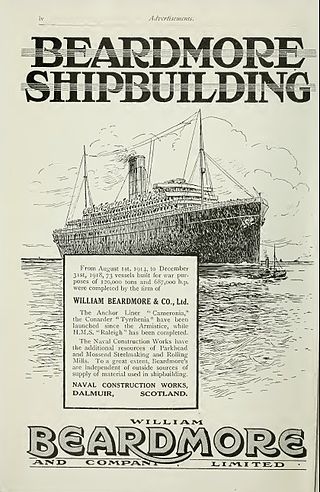
William Beardmore and Company was a British engineering and shipbuilding conglomerate based in Glasgow and the surrounding Clydeside area. It was active from 1886 to the mid-1930s and at its peak employed about 40,000 people. It was founded and owned by William Beardmore, later Lord Invernairn, after whom the Beardmore Glacier was named.
Dalmarnock is a district in the Scottish city of Glasgow. It is situated east of the city centre, directly north of the River Clyde opposite the town of Rutherglen. It is also bounded by the Glasgow neighbourhoods of Parkhead to the north-east and Bridgeton to the north-west.
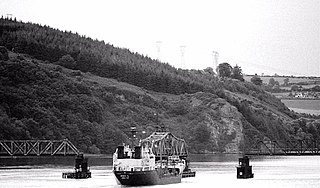
Barrow rail bridge,, is a pratt truss type of railway bridge that spans the river Barrow between County Kilkenny and County Wexford in the south east of Ireland. This rural landmark with a length of 2,131 ft (650 m) is the longest bridge on the river. It was second longest bridge in Ireland and the third longest rail bridge on the islands of Ireland & Great Britain. Designed by Sir Benjamin Baker and built by the firm of Sir William Arrol. It is known locally as Barrow Bridge.

Sir William Arrol was a Scottish civil engineer, bridge builder, and Liberal Unionist Party politician.

The Tay Bridge disaster occurred during a violent storm on Sunday 28 December 1879, when the first Tay Rail Bridge collapsed as a North British Railway (NBR) passenger train on the Edinburgh to Aberdeen Line from Burntisland bound for its final destination of Dundee passed over it, killing all aboard. The bridge—designed by Sir Thomas Bouch—used lattice girders supported by iron piers, with cast iron columns and wrought iron cross-bracing. The piers were narrower and their cross-bracing was less extensive and robust than on previous similar designs by Bouch.
Lithgows Limited is a family-owned Scottish company that had a long involvement in shipbuilding, based in Kingston, Port Glasgow, on the River Clyde in Scotland. It has a continued involvement in marine resources.

Wearmouth Bridge is a through arch bridge across the River Wear in Sunderland. It is the final bridge over the river before its mouth with the North Sea.

The Forth and Cart Canal was a short 1⁄2-mile (800-metre) link canal which provided a short cut between the Forth and Clyde Canal, at Whitecrook, and the River Clyde, opposite the mouth of the River Cart. It was intended to provide a transport link between the town of Paisley, the Firth of Forth and Port Dundas, Glasgow, without having to go via Bowling, some 7 miles downstream on the Clyde. The Forth and Cart Canal was closed in 1893. Railway works destroyed most of it soon afterwards.

Titan Clydebank, more commonly known as the Titan Crane is a 150-foot-high (46 m) cantilever crane at Clydebank, West Dunbartonshire, Scotland. It was designed to be used in the lifting of heavy equipment, such as engines and boilers, during the fitting-out of battleships and ocean liners at the John Brown & Company shipyard. It was also the world's first electrically powered cantilever crane, and the largest crane of its type at the time of its completion.

The Caledonian Railway Bridge is a bridge crossing the River Clyde at Broomielaw in Scotland. It is adjacent to Glasgow Central station.
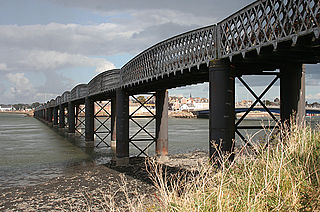
The North British, Arbroath and Montrose Railway was a company established by Act of Parliament in 1871 to construct and operate a railway line from north of Arbroath via Montrose to Kinnaber Junction, 38 miles (61 km) south of Aberdeen. The company was originally a subsidiary of the North British Railway but was absorbed into its parent in 1880.
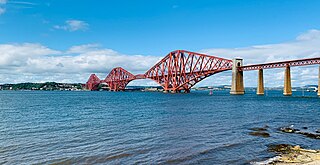
The Forth Bridge is a cantilever railway bridge across the Firth of Forth in the east of Scotland, 9 miles west of central Edinburgh. Completed in 1890, it is considered a symbol of Scotland, and is a UNESCO World Heritage Site. It was designed by English engineers Sir John Fowler and Sir Benjamin Baker. It is sometimes referred to as the Forth Rail Bridge, although this has never been its official name.

The Fairfield Titan was a giant cantilever crane at BAE Systems' Govan shipyard, and the largest such crane on the River Clyde until it was demolished in 2007.
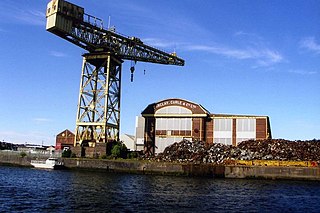
The Barclay Curle Crane is a disused Titan or giant cantilever crane at the Barclay Curle shipyard at Whiteinch, Glasgow, Scotland.

A block-setting crane is a form of crane. They were used for installing the large stone blocks used to build breakwaters, moles and stone piers.

The Arrol Gantry was a large steel structure built by Sir William Arrol & Co. at the Harland and Wolff shipyard in Belfast, Ireland. It was built to act as overhead cranes for the building of the three Olympic-class liners.























